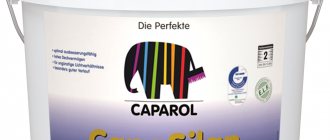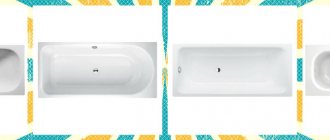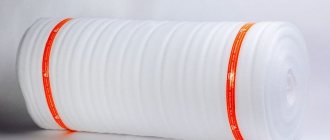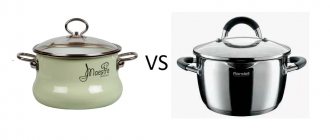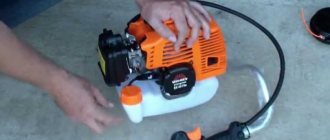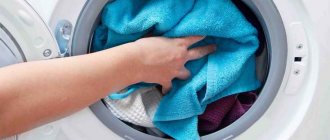Currently, the consumer has the opportunity to choose household appliances that suit him not only in price, but also in appearance. When choosing a washing machine, a person can purchase a machine with horizontal or vertical loading. The main difference between them is the location of the loading hatch. For front-loading washing machines it is located on the front panel, and for vertical models it is on the top. To load laundry into a front-loading machine, simply open the hatch. For vertical cameras, the loading process will be a little more complicated: first you need to open the top cover of the case, and then open the lock on the drum itself.
Questions and Answers Why is there an unpleasant smell in the washing machine?
Once upon a time, the choice of a machine with horizontal or vertical loading was influenced by the area of the room. Now, among all types of models, you can choose a machine that will easily fit in a small bathroom. But there is one caveat: when installing a washing machine, you always need to provide free space for the hatch, which swings open to the side, usually to the left. When buying a front-loading machine, you should keep in mind that there should be no furniture in front of it at a distance of at least one meter.
According to experts, the choice of a specific washing machine model depends on which loading method is more convenient for the consumer. For some, the front one is more comfortable, while others prefer to load the machine from the top. This does not affect the quality of washing. “Everyone is looking for convenience for themselves. But in general, if you look at professional washing machines, they are never made with vertical loading. Only from the front. But whether such a load is better or worse is a matter of personal preference and a purely personal evaluation criterion,” says expert on large household appliances Ernest Yudaev .
How does a washing machine work? Infographics Read more
How well the machine will cope with various stains depends more on the specific model, its functions and washing class than on the location of the lid. Before going on sale, washing machines undergo special testing. Depending on how well they wash heavy stains in the standard mode, they are assigned one of seven washing classes, designated in Latin letters from A to G. The higher the class, the better the quality of washing.
Thus, in order to accurately decide which is better, a vertical hatch or a horizontal one, you need to study what functions the machine has, how well it washes and what its overall dimensions are.
Question answer
What items cannot be machine washed?
Design and differences between vertical and front loading washing machines
In the 2000s there was a hot battle between an automatic and a semi-automatic. Automation has won. The lion's share of washing machines are fully automated; you just have to choose between vertical or front loading. Which one is better is not clear.
- In the first case, the lid is located on top. You need to pick it up, throw the laundry into the drum and close it.
- In the second case, the hatch is located in front. You will have to sit down or bend over to load and unload laundry. And you can put the necessary accessories on the lid of the washing machine.
This is where the key differences end. Both models wash equally well. More on minor differences below.
Read: What is the difference between an automatic washing machine and a semi-automatic one: 7 key points
Life time
The operating time depends not only on the quality of the parts and the accuracy of their installation. This parameter is directly influenced by the intensity of use of equipment, and, accordingly, by the wear rate of components and mechanisms. The service life is largely affected by the vibration that occurs during spinning. The reasons for this phenomenon are poor alignment and improper placement of linen. There are nuances that depend on the type of technology.
So, in vertical models all the parts are located extremely close. Even slight vibration spreads to the components, causing them to quickly wear out and break down. Another factor is the likelihood of the drum door opening during the wash cycle. The shaking weakens the lock and comes out of the grooves. If this happens during spinning, the drum becomes deformed and replacing it is an expensive undertaking. According to statistics, vertical equipment breaks down more often, and its repair costs more.
Equipment with a front hatch is more reliable and durable if the level is correctly set and the loading weight is observed.
When these rules are not followed, the machine begins to shake violently during the spin cycle. At best, the belt falls off, and at worst, the bearing breaks.
Dimensions and required space
Front-facing cameras are more versatile. Any size: from miniature - for a smart apartment, to huge professional units.
There are 4 types in total - more details about each in the table.
| Parameter | Vertical washing machine type | |||
| Full size | Narrow | Ultra-narrow | Compact | |
| Height | 85-90 cm | 68-70 cm | ||
| Width | 60 cm | 47-50 cm | ||
| Depth | 60 cm | 35-45 | 32-38 | 43-45 cm |
| Average load | 5-7 kg | 2.5-3 kg | ||
Vertical devices do not have this choice. Often their dimensions come down to three parameters:
- height - 75-92 cm;
- width - from 38 to 42 cm;
- depth - from 57 to 63 cm.
The “tops” are always narrow, they can even be placed in the corner of a small room. The front ones require space, but you can monitor the washing. Kids and animals are glued to this spectacle for a long time. And yes, you can store tubes, jars and other things on the lid. Upper type devices do not have this advantage.
Useful article: How to choose an automatic washing machine based on 7 parameters: review, comparison and reviews
Might be interesting:
- Rating of the best washing machines with dryers TOP 10 models
- Narrow washing machine customer reviews
- Review of popular brands of kitchenware
- Microwave oven Mestel MO900
- Health disc Gracia - exercise machine for home
- Copy iPhone X (Taiwan)
- Copy iPhone 8 (Taiwan)
- Willson Silane Guard liquid glass for cars
- Grafen Master - undull knives
- BioGrow (Biogrow) - biofertilizer and plant growth activator
What is the difference between hatches of models with different types of loading?
Nothing. Both of them do the washing well. Therefore, when trying to understand which washing machine will be better: vertical or frontal, you should focus on the loading features. That's all. As we are used to, this is the final choice.
Hatches of vertical washing machines
You can add things to them directly during washing. Advanced vertical models have a “parking system”. The drum always stops with the flaps facing up.
Outdated devices suffered from the lack of such a system. You had to screw it up yourself.
Useful article: Why the water does not drain from the washing machine - 5 ways to drain the water manually
Best models
We present an overview of several models of automatic washing machines of both types, combining a harmonious balance of characteristics, price and quality.
Vertical
Indesit ITW A 5851 W
pros
- Convenient location of program management
- The drum opens and closes easily
- Washes and spins clothes well
- High quality build
Minuses
- Noisy when washing
From 25600 ₽
The model with a capacity of up to 5 kg is equipped with intelligent electronic control, 18 programs and several degrees of protection. Maximum spin speed – 800 rpm. The width of the case is 60 cm, there are wheels on the bottom for easy movement. The Indesit machine does not have a display, but each setting is indicated by a light indicator. The unit belongs to class A in terms of energy consumption and washing efficiency. Quite a nice, high-quality vertical washing machine at an affordable price.
Slavda WS-30ET
pros
- Easy to use
- Compact
- Works quietly
- Lightweight, can be carried from place to place
Minuses
- Lack of full spin
From 3100 ₽
A small-sized and very simple in functionality activator-type machine, belonging to the budget class. Its height is 63 cm and width is 41 cm. There are no “chips” in it and only 2 washing programs are provided. Nevertheless, it is quite high quality and practical. The model will be a profitable solution for a summer residence and will save you from hand washing during the financial crisis. The average price of Slavda WS-30ET is 3100 rub.
Candy Vita G374TM
pros
- High-quality spin at 1400 rpm
- Convenient, intuitive controls
- Compact, takes up little space
- Fits a lot of laundry
Minuses
- The powder compartment is clogged
From 21800 ₽
A vertical washing machine with advanced functionality holds 7 kg of laundry. The Candy model is assigned energy consumption class A+++, intelligent electronic control is complemented by a display. The number of programs is 16; laundry can be spun at speeds up to 1400 rpm.
The device has a delay start timer for up to 24 hours. The following protective systems are provided: foam level control, leakage protection, drum imbalance control. This is one of the best cars in its category, which can be bought for 26,000 rubles.
Whirlpool AWE 6516
pros
- Simple and reliable design
- Removes even stains that cannot be washed by hand
- Many washing programs
- Woolen items can be washed
Minuses
- Noisy
From 23500 ₽
Those who decide to choose a vertical washing machine can take a closer look at the model from Whirlpool. The device is fully automated, the machine holds 5 kg of laundry, has a large number of programs and several levels of protection. Any program can be supplemented with your own settings. Spin speed – up to 1000 rpm. Estimated price from 23,000 rub.
Brandt WTD 6384 K
pros
- There is a clothes dryer
- Convenient, intuitive interface
- Small dimensions
- Programs can be customized to suit your own needs
Minuses
- Jumps during the spin cycle
From 56000 ₽
One of the most expensive models, equipped with a drying function. The machine is designed for 6 kg of laundry, equipped with 13 programs and additional manual settings. It has a delay start timer and a display on the body. The laundry is spun at a speed of 1300 rpm. The device has a memory option and can remember the last manual settings for each category of things.
Frontal
Hansa ProWash WHP8141DBLS
pros
- Roomy (up to 8 kg)
- There is a function for reloading laundry
- Low noise level: 78 dB during spin and 54 dB during washing
- Automatic dosing of detergents (Opti Dose)
- Steam wash
Minuses
- There is no separate spin mode, only through rinsing
From 17300 ₽
The front-loading washing machine can hold up to 8 kg of laundry in its drum. It has a fairly large hatch and an economical energy class (A+++). There are 16 preset programs, and manual settings are also provided. The case is protected from leaks, there is protection from foam, from drum imbalance and from children. The delay start timer lasts 24 hours. The large display shows all selected settings and program progress.
Samsung WW65K42E08W
pros
- There is a very fast wash mode - 15 minutes
- There is a hatch for adding things directly during washing
- Steam wash function
- Well balanced
Minuses
- A bit noisy when spinning
From 20300 ₽
One of the latest models from Samsung, updated with new features. The maximum load is 6.5 kg, the machine allows you to reload during washing. The control is completely electronic, with a display installed on the body. There are 12 automatic programs, each can be adjusted. Among the advantages, we can note the option of cleaning the drum and a ceramic heater protected from scale.
LG FR-296WD4
pros
- Very quiet during washing
- Price/functionality ratio
- Has a large number of programs
- Nice design
Minuses
- At the end of the wash, you can open the hatch only after a minute
From 20500 ₽
The free-standing front washing machine holds 6.5 kg of laundry. Spin speed – up to 1200 rpm, number of programs – 13. Stylish design combined with the latest technologies make this machine a practical solution for the home. The LG machine has a special Smart Diagnosis mobile diagnostic function and “6 care movements” technology. The multi-stage protection system significantly extends the life of the device. The approximate cost of the unit is 23,000 rubles.
Bosch WLT 24460
pros
- When spinning at 1200 rpm, the laundry is almost dry
- Very quiet
- There is an intelligent washing mode
- Shows the recommended laundry weight on all programs
- Collapsible drum
Minuses
- Doesn't weigh laundry
From 20150 ₽
Bosch has always been associated with quality and reliability. The Bosch WLT 24460 washing machine is equipped with 15 programs, a maximum spin speed of up to 1200 rpm, a delay start timer, and a drum for 7 kg of laundry. The model has the ability to select the washing temperature, a signal for the end of the program is set, and the extended functionality includes soaking, stain removal, and pre-wash modes.
Front washing machine hatches
The transparent window is the signature feature of front-facing cameras. It is made of impact-resistant plastic, like the Indesit BWSA 61253 W EU - so that buckles made from washable items do not accidentally break the window. During washing, the equipment turns on a special lock and securely fixes the door. It will open only after there is no water in the tank. To protect the machine from leaks, a rubber cuff is placed on the door.
It is in such washing machines that manufacturers experiment with adding innovations:
- drying - present even in a number of budget models. An excellent choice for those who have nowhere to dry their laundry. True, after treatment with heat, the laundry still remains slightly damp;
- auto-dosing of detergent - just pour or add detergent once, and the machine will independently dose it for 15-20 washes;
- rocking - the washer can imitate other hand movements when washing. The most common types are rocking, smoothing, saturation, and twisting;
- ironing clothes with steam - at the end of washing, items are doused with steam to disinfect and soften the resulting wrinkles;
- bubble wash - breaks powder grains into atoms, which penetrate the structure of the material and wash away dirt. This feature is a lifesaver for allergy sufferers. The laundry is thoroughly rinsed and does not cause irritation;
- reloading laundry - you no longer have to urgently turn off the machine, drain the water from it and open the door just to throw in a few blouses. Just press one button and you can add forgotten things;
- Intelligent washing control - the machine itself will analyze the load on the drum and select the required amount of powder and water.
- Wi-Fi and NFC - will allow you to remotely start the washing machine (which is very convenient for those who need to wash things by a certain time), regulate the washing process, and change washing modes while being far from the washing machine. By downloading a proprietary application (the name is in the instructions), the machine itself will be able to give recommendations on its effective use: the program will analyze the user’s behavior patterns, offering him options to choose from.
Note: Instructions in 5 points on how to properly ground a washing machine with your own hands
The size of the hatch ranges from 20-40 cm. The more spacious the unit, the more voluminous it is. It is better to choose models with a large hatch - then it will be much easier to put in and take out laundry. Front-facing cameras have a larger drum size than vertical devices of the same dimensions. Some models can hold up to 10 kg of items. You can even wash the blanket.
The washing machine doors open at different angles:
- simplified models swing open 80-110°;
- advanced - up to 180°.
Such models can be integrated into any interior, including built-in wardrobes. However, you need to take into account the layout of the room: there should be enough space for air circulation, connecting hoses, etc.
In models with one drum, it is not possible to add laundry during washing. Units with two drums are more practical in this regard, but still cost incredible amounts of money. This choice will be justified in very large families and HoReCa establishments.
Useful article: A bra bone got into the washing machine - 3 solutions
Specifications
When trying to understand which models are the best: vertical or frontal, it is worth taking into account other criteria that washing machines have.
Before purchasing equipment, you should ask what characteristics the model you like is equipped with. Because the presence of one specific program or function that is not so important for you can increase the cost of the device.
When choosing, pay attention to the following parameters:
- tank capacity;
- spin class;
- washing class;
- energy consumption class;
- types of washing programs;
- additional functions;
- country, manufacturer, brand;
- reviews from experts.
To decide which washing machine is best to buy, it’s worth understanding in more detail what these indicators are.
Optimal capacity
An important criterion when choosing equipment is the capacity of its tank. It is determined in kilograms. Most modern devices are equipped with a drum with a loading capacity of up to 6 kg. This means that the owner of the equipment has the opportunity to load no more than 6 kilograms of laundry per wash.
If you exceed the permissible limit, your machine will refuse to start the wash cycle.
For your information, one set of bed linen weighs about 2 kg. If you don't plan to wash heavier items, such as duvets or winter outerwear, then you shouldn't overpay for more expensive models. You can choose a narrow washing machine, for example, from Beko, with a maximum allowable load of dry laundry of 5 kg, or Indesit, with a capacity of 4 kg. Both of these manufacturers set relatively affordable prices for their products.
Of course, if you plan to wash a lot, and periodically also blankets, rugs and pillows, then consider machines with a capacity of 7 kg and above. Just keep in mind: the higher this figure, the higher the cost of the unit will be.
Energy saving class
Absolutely any modern washing machine has its own energy efficiency class.
Generation of cars until 2010: markings were carried out with letters of the English alphabet from A to G.
New generation units:
- A+++ - the most economical;
- A++;
- A+;
- A;
- B;
- C;
- D is the highest energy consumption level.
As you might guess, the most economical devices are those that have an A+++ energy consumption class. But do not rush to succumb to pressure from manufacturers. Obviously, when your refrigerator runs 24 hours a day, 7 days a week without interruption, it makes sense to choose the lowest energy consumption level. Of course, in this case the savings will be noticeable. But what about a washing machine that you use 2-3 times a week?
Energy saving classes of washing machines
The average time it takes for equipment to wash, rinse and spin clothes is about one and a half to two hours. How significant will the savings be for your wallet in this case? If you do not have the opportunity to overpay for a model equipped with class A+++, opt for A. Moreover, many modern devices, even from the budget category, have this particular energy efficiency class.
Washing class
Washing classes, as well as energy efficiency, are indicated by letters borrowed from the English alphabet:
- A;
- IN;
- WITH;
- D;
- E;
- F.
There are six classes in total. The method for determining the quality of washing was recorded in 1995. Its principle is very similar to advertising washing powder. A piece of fabric having an approved size and dirt is loaded into the washing machine, and a one-hour wash is started at 60 degrees. A technique that can wash this flap better than the existing standard is assigned class A. If the quality does not differ in any way from the standard, then B.
Washing machine washing classes
It is worth noting that it is almost impossible to notice the difference with the naked eye. But after repeated washing, it will be possible to see something. However, so many years have passed since this technique was proposed, and so much has happened: new powders have appeared, new equipment equipped with advanced technologies, that almost all automatic washing machines are currently assigned class A. The only exceptions are rare specimens.
Spin class
This indicator is similar to the washing class and is determined according to international standards. The spin class is a parameter that indicates the number of drum revolutions per minute at the time of spinning the laundry. The highest level corresponds to the English letter A, it is assigned if no more than 45% moisture remains in the laundry that has undergone this procedure. This class corresponds to more than 1500 rpm.
Spin classes
But think about it, do you really need your machine to spin the drum with such intensity, because you will have to pay a lot for a high rate? And this is not the only negative point that you get for relatively “dry” laundry. You will have to sacrifice its appearance.
After spinning at such speeds, the clothes are unlikely to look good; you will have to make a lot of effort to iron them and give them a decent look.
Let's see which class corresponds to the residual percentage of moisture in the laundry and the number of revolutions:
- A - over 1500 rpm - 45%;
- B - 1200-1500 rpm - 54% or less;
- C - 1000-1200 rpm - 63% or less;
- D - 800-1000 rpm - 72% or less;
- E - 600-800 rpm - 81% or less;
- F - 400-600 rpm - 90% or less;
- G - no more than 400 rpm - more than 90%.
Most modern washing machines have a spin class of C or B.
Types of programs
Many people probably remember that just a dozen years ago, washing machines could not boast the same functionality as they do now. Housewives had only 2-3 modes at their disposal, choosing between cotton, wool and delicate fabrics. Currently, almost every manufacturer of washing machines, be it Indesit, LG, Electrolux or Bosch, has awarded the equipment with such functionality that you really begin to believe in the need to have all the capabilities offered. Let's look at the most common modes most machines are equipped with:
- cotton mode;
- delicate wash or hand wash;
- quick wash;
- wool mode;
- duvet blanked;
- dark fabrics;
- sportswear;
- Kids' things;
- outerwear;
- hypoallergenic wash;
- steam wash;
- bed linen, etc.
Types of washing machine programs
However, reviews from experts indicate the opposite trend. Indeed, 99% of all users constantly use only a few modes. With their help, you can wash clothes from any type of fabric and any degree of soiling. Other programs are used based on personal wishes. But still, they help facilitate the process of washing clothes of a certain texture.
Which one is better to choose and for what purposes?
And yet, which washing machines are better: frontal or vertical? We highlight the main points.
- For front-facing cameras, the hatch, containers and control system are located at the front. The lid is released for storing bath accessories. For example, Samsung WW60J32J0PW/UA can be used as a cabinet. Smaller models can be placed under the washbasin or built into furniture. Some models have a drying function. Verticals don't have it.
- Vertical machines are good for small spaces. They save space. It will not be possible to build it in and use it as a cabinet.
Interesting article: How a washing machine works - the device and operating principle of the machine. 5 main washing steps
"Pros" and "cons" of each type
To soberly assess which is better: vertical or front loading, you need to understand the pros and cons of each. All of them are collected in the tables below.
| Front loading machines | |
| Advantages | Flaws |
| Huge selection of designs and sizes. Expressive representative - Beko WUE6512XBA | Required to bend over to unload and load laundry |
| Can be built in or used as a cabinet | Needs more space to open the hatch |
| A spacious drum with a wide hatch into which blankets and pillows can fit | The door lock often breaks and repairs are expensive |
Verticals have other features that you need to be prepared for.
| Top loading machines | |
| Advantages | Flaws |
| Compactness | Cannot be used as a nightstand |
| No need to bend over to load | Can't embed |
| Less temptation for a child to climb into the drum | Small opening for loading |
| You can add items while washing | All cars are alike |
Useful article: Instructions for the washing machine: 7 secrets of effective use of equipment
A few convenience issues
This point also needs to be given attention. Which machine is still more convenient to use? To answer such a question, subjective factors must be taken into account. Often a person simply likes vertical loading, since he is more accustomed to it, and there is no explanation for this. The same can be said about cars with a front hatch. You should not focus on subjective aspects; it is better to immediately consider the objective reasons that make this or that group of washing machines convenient:
- For vertical group cars, the hatch is located on top. When loading laundry you will not have to bend over, and this is very convenient for users suffering from radiculitis,
- For washing machines with a front hatch, the top panel is free. Many people place cans, bottles, bags of powders and other things on its surface, finding a certain convenience in this. But the buttons and elements of the touch group are located on the front panel. On the left there is a tray with three compartments, where you can pour washing powder, liquid soap and fabric softener,
- the front model can be installed under the countertop, but the vertical model will require free space on top,
- In a front group machine, the tray for detergent compositions can be easily removed, and it is much more convenient to use. Owners of a vertical unit claim that their model is very convenient in this sense, but their opinion remains in the overwhelming minority.
Design
This question is of no small importance for people who do not want household appliances to spoil the interior of the room. The industry produces washing units in several colors, among which any consumer will find the right option for themselves.
So, on sale are models finished in the following tones:
- white;
- black;
- under the tree;
- under steel;
- turquoise;
- creamy.
An interesting approach for horizontal-type products was the addition of a hinged door to the body, covering the entire front part. If necessary, you can cover the canvas with a film that matches the color of the objects surrounding the device.
Prices
The price of good and high-quality equipment cannot be low. But this axiom does not entirely apply to vertical models. While inferior to their horizontal counterparts in terms of functionality, they are more expensive. This is largely due to the complexity of their design and assembly. Another reason is low demand and almost complete lack of competition, which has resulted in limited supply in the market. In this regard, the seller sets the price, and the buyer has no choice but to pay it.
The cost of middle-class frontal models varies between 15,000-25,000 rubles, vertical analogues cost 20-30% more.

